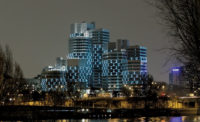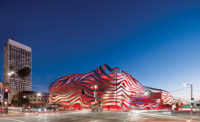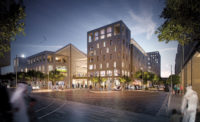A two- to three-hour drive from the bright lights of Southern California’s largest cities, Borrego Springs—a small town bordering the Anza-Borrego Desert State Park in northern San Diego County—became the world’s second official Dark-Sky Community in 2009. Drawn to the area’s austere beauty and beautiful night sky, L.A. transplants Richard Orne, an architect, and his wife, Susan Hancock, a landscape designer and color consultant, bought 10 acres five miles from the center of town and built a sustainable house. The glazed moment-frame structure is 142 feet long by 28 feet wide, with deep overhangs on the northeast and southwest sides. In compliance with the community’s guidelines, derived from county codes and International Dark-Sky Association lighting basics, Orne used as little lighting as possible. He limited the outdoor fixtures to shielded 2700K downlights under the overhangs and over four decks on the building’s northwest. These are tied to photosensors programmed to turn them on at dusk and off at dawn. (A manual override allows them to be shut anytime.) The interior, divided into five sections along its length, is illuminated by recessed 2700K to 3000K LEDs on dimmers. In the evening, when a particular zone is not in use, it remains dark. “Very little light escapes from the house,” says Orne. “It’s more like a low-glowing lantern.” There are even nights they turn all of the lights off. During a full moon, he adds, there is plenty of light without them.







Post a comment to this article
Report Abusive Comment